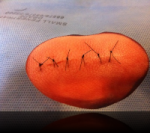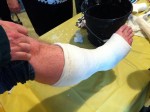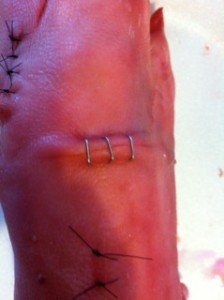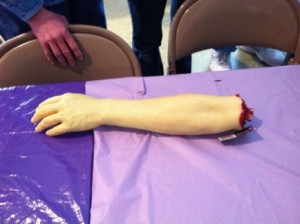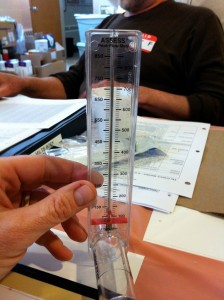The following post on self-defense and medical preparedness is fifth in a series by Pete Farmer, who holds advanced degrees in research biology and history, and is also an RN and EMT.
* * *
In the previous installment of this series, we considered the physical side of securing your clinic, aid station, or hospital. Now let us turn our attention to people and how to handle them inside/around your facility. As a medic and caregiver, you probably recoil at such terms as “crowd control” and “managing” people – but make no mistake, handling the flow of people is essential to delivering timely medical care in the safest and most effective manner possible. Let’s consider some specifics.
Managing the Flow of People
The manner in which you and your staff handle those people waiting to be treated (more below in the section on triage), their relatives, friends, and family, and others who may be present has a great bearing on patient outcomes and the overall effectiveness of your on-going operations.
Ideally, your facility is situated in a building or other location that permits a degree of restricted or controlled access. If you do not already have security guards in place, get some. Their presence should be low-key; unless it is absolutely necessary in your present situation, you do not want heavily-armed personnel with cocked-and-locked weapons wandering around. The patients and their families are already upset and stressed, and suffering from some sort of illness, injury, or wound; exacerbating these stresses is undesirable.
If available, a person is designated to act as a gatekeeper and to receive patients administratively, i.e. taking their names, relevant identifying information, and basic data about the patient’s complaint. This person, usually a nurse or medic, may be qualified to perform triage – or not – depending on circumstances. At this time, the patient should get an identification tag, bracelet or similar device, which assigns a unique alpha-numeric designator along with the patient’s name and any other desired information. Don’t forget to post any relevant rules, procedures, and policies followed by your facility, and to make newly-arrived people aware of them. An important part of the gatekeeper’s function is to keep family, friends, and others in the waiting area appraised of the on-going care of patients to whom they are related, and to handle whatever questions and concerns arise.
If you are dealing with a high volume of people, and have the space and materials necessary, setting up a waiting room is a good idea. Even if you lack chairs and tables, an open space or room under cover and out of the elements will be needed. It should be as clean as your circumstances permit, preferably treated with an antiseptic. This space can be subdivided into a waiting room for those not being treated, and a receiving area for those awaiting treatment. Most modern emergency departments have a separate entrance and receiving area for incoming patients.
Crowd Control
If your clinic is operating in conditions where very large numbers of people are present, such as a mass casualty event or humanitarian crisis involving refugees, you will likely be dealing with crowd control. For lack of a better term, “crowd control” is taken to mean handling the large numbers of people, non-patients, who tend to accompany such events.
A complete consideration of the challenges of crowd control is beyond the scope of this series, but a few basics and first principles are in order. If you’ve read the previous installments in this series, you already understand the necessity for security personnel, adequately-chosen and sited facilities, and the need for organization and management of people. Large crowds not only pose a physical security risk, but in cases of an epidemic or communicable disease outbreak, may pose a public health risk.
Very large numbers of people can be dealt with in an orderly and humane fashion, but it takes skills and training outside the purview of most health care professionals. The last thing you want is a mob-type situation, where people get out of control, riot, or otherwise become unpredictable or violent. Simply put, you need outside assistance – preferably from law-enforcement or military personnel trained to handle such situations, or failing that, a group of people whose only job is to manage the crowd. If the numbers inside and outside your clinic are getting unmanageable, don’t hesitate to ask for help.
Typically, in a humanitarian crisis, refugees or others needing medical care are separated (triaged) from those who are healthy but simply need food and shelter, which can then be provided separately in encampments, food lines/kitchens, etc.
Triage
Even under everyday operating conditions, deciding upon priority of care among multiple patients is a challenging process in a primary-care clinic or acute care hospital alike. Just ask any ER nurse or receptionist at a doctor’s office. The word triage comes from the French verb trier, meaning to select or separate. The practice of triage is defined (Wikipedia) as “the process of determining the priority of patients’ treatments based on the severity of their condition. This rations patient treatment efficiently when resources are insufficient for all to be treated immediately.” Effective triage is even more essential under conditions of operational and disaster medicine, when the medical system may be swamped with too many patients or casualties requiring care, and too few medical personnel to deliver it.
Historically, battlefield medics and corpsmen were trained as recently as World War Two to assess and sort casualties (patients) into three categories: those who will probably survive, no matter what care they receive; those who will probably die, regardless of care received (expectant); and those for whom immediate treatment can result in a higher probability of survival. Today, four designations are used by battlefield medics – immediate, delayed, minimal, and expectant. In the U.K., a numbering system is used, from 1 (most urgent) to 4 (likely to die).
Another system of simple triage is the START (Simple triage and rapid treatment) model, which uses four categories – the expectant, who are beyond help; those who can be saved by immediate transport; those for whom transport can be delayed; and those with minor injuries or afflictions who need help less-urgently. The START system was developed for use by lay people or lightly-trained medical personnel, and has been employed successfully in mass casualty events. START typically uses a color-coding or tagging system, and can begin in the field before transport.
More advanced systems of triage, including algorithms and protocols, are available and in-use by physicians and other highly-trained and well-equipped personnel.
Triage in most hospitals is usually – but not always – handled by the triage nurse, who is often an RN of long experience in emergency and critical care. The ability to recognize primary care and mental health issues and related complaints is also highly desirable, since these types of cases are also seen quite frequently in emergency departments. Who is chosen to do triage, and what system is employed, will depend on how many caregivers you have, their level of training, and the other specifics of your situation.
Triage results in better patient survivability and outcomes, and is also a means of rationally allocating resources – human or material – when they are insufficient or not immediately available. As such, it is a critical tool for sorting and treating patients in a fair, compassionate manner.
This concludes the series on self-defense and medical preparedness. As always, your questions, comments, or corrections are welcome.
Copyright © 2012 Peter Farmer



